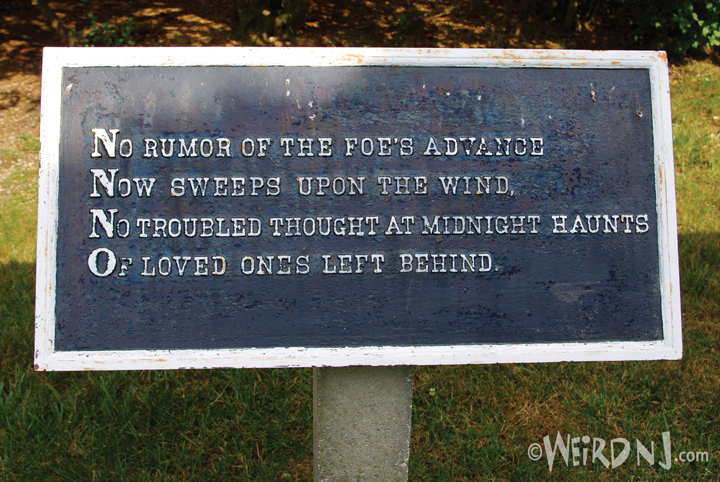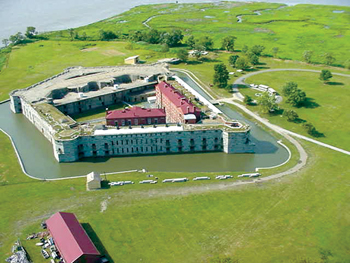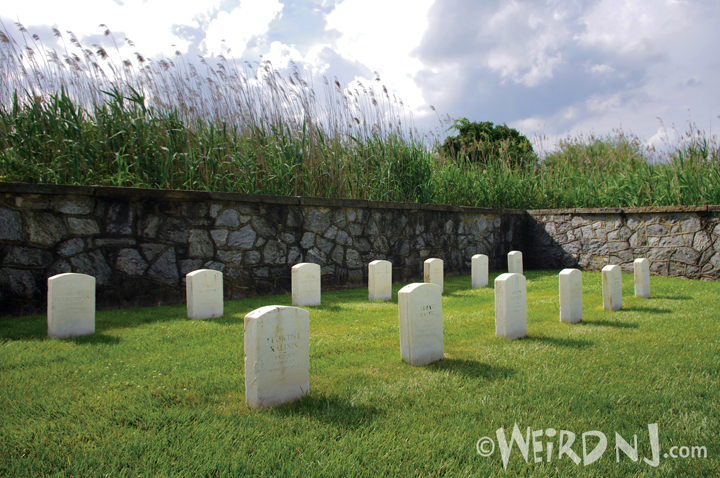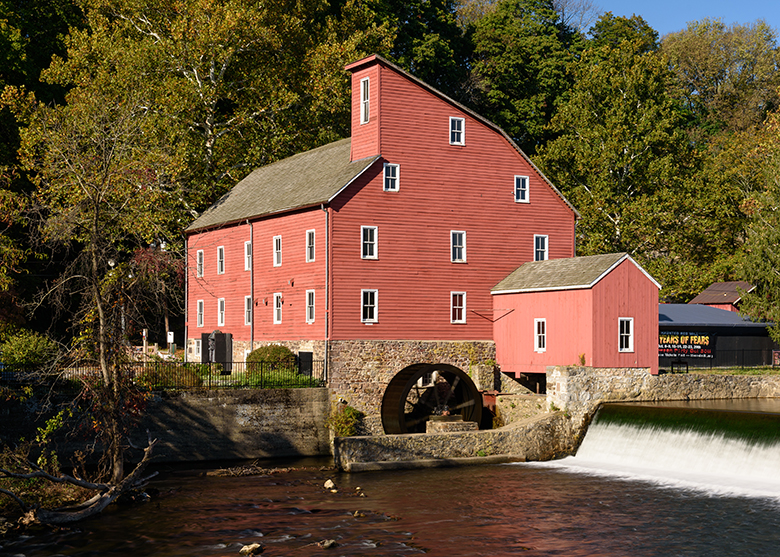Confederate and WWII Prisoner Graves of Finn’s Point Cemetery
New Jersey has plenty of history surrounding the Revolutionary War but not many people know about its Civil War connections. This Memorial Day weekend we take you to a place called Finn’s Point National Cemetery, located on the Delaware River in Pennsville Township, NJ (Salem County), that was used as a mass burial ground for Confederate prisoners of war who died while imprisoned at Fort Delaware. It encompasses 4.6 acres and includes 3,033 interments.
Fort Delaware, built in 1859, sits in the middle of the Delaware River on Pea Patch Island across from Finn’s Point National Cemetery. The Union fortress once housed Confederate prisoners of war. The fort was originally built to protect the ports of Wilmington and Philadelphia. The commander of Fort Delaware during the Civil War was General Albin F. Schoepf and was not fond of the Confederate prisoners, who nicknamed him “General Terror.
Fort Delaware on Pea Patch Island in the middle of the Delaware River.
The conditions of the prison were deplorable, and prisoners were afflicted with smallpox, measles, diarrhea, dysentery and scurvy. The prison was set up to house 4,000 prisoners, but by the end of the war, there were over 12,000 inmates. The prison became known as “Andersonville of the North,” because of similar inhumane conditions at the Andersonville Prison in Sumpter County, Georgia, where almost 13,000 Union prisoners died of malnutrition, exposure and disease. Andersonville and Fort Delaware became synonymous with the atrocities that both Northern and Southern soldiers experienced as prisoners of war.
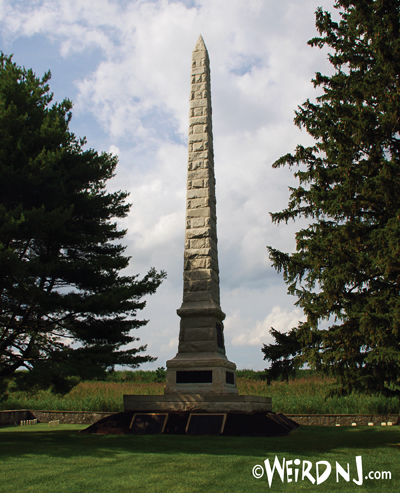 Confederate monument bearing the names of the 2,436 southern soldiers who died while imprisoned at Fort Delaware.
Confederate monument bearing the names of the 2,436 southern soldiers who died while imprisoned at Fort Delaware.
Approximately 2,700 Confederate soldiers died while being held captive at Fort Delaware. 2,436 Confederates are interred at Finn’s Point National Cemetery. The last prisoner was released from Fort Delaware in 1866. The Fort was abandoned in 1944, and in the 1950s the non–profit Fort Delaware Society organized preservation efforts. Fort Delaware became a Delaware State Park in 1956. Finn’s Point National Cemetery is governed by the U.S. Department of Veterans Affairs and administrated by the Washington Crossing National Cemetery. Among the noteworthy monuments are: the Confederate Monument, an 85-foot tall granite obelisk, erected in 1910 by the federal government bearing the names of the 2,436 Confederate prisoners of war who died at Fort Delaware,
![]() and the Union Monument, dedicated in 1879 to 135 Union soldiers who died while on duty at Fort Delaware. But perhaps the most unusual and unexpected graves in the cemetery are to be found in the northwest corner, where 13 white marble headstones mark the burial place of German prisoners of World War II who died while in custody at New Jersey’s Fort Dix.
and the Union Monument, dedicated in 1879 to 135 Union soldiers who died while on duty at Fort Delaware. But perhaps the most unusual and unexpected graves in the cemetery are to be found in the northwest corner, where 13 white marble headstones mark the burial place of German prisoners of World War II who died while in custody at New Jersey’s Fort Dix.
13 white marble headstones mark the burial place of German prisoners of World War II who died while in custody at New Jersey’s Fort Dix.
A Visit to Fort Delaware and a Finn’s Point Murder
Fort Delaware is located on Pea Patch Island in the middle of the river and is officially part of the state of Delaware. The fort itself is an eerie place to visit. It has been described as the “Andersonville of the North” due to the number of deaths there after the prisoners arrived. Andersonville was the infamous Southern prison used for captured Northern troops and was notorious for the mistreatment of prisoners.

The fort is a cold, drab stone fortification, which today can be access by ferryboat from either the New Jersey or Delaware shores. It has been open to the public for many years and Civil War reenactors give tours and lectures. In the past they demonstrated how to load and fire the cannons but this had to be discontinued after World War II. The last time a cannon was fired was around the year 1946. A Japanese freighter was coming up the Delaware River toward Philadelphia when a shot was fired across its bow. Since this happened so soon after the end of war the Japanese sailors were very alarmed, stopped their ship and refused to pass the island. The shipping lane was blocked for hours until the Japanese captain could be reassured that hostilities hadn’t been resumed between the United States and Japan.
States and Japan.
I was visiting the cemetery in late 1997 and dutifully reading the obelisk erected to the unmarked graves of the prisoners when a couple came up to me and said, “Did you know that the caretaker’s house over there is where the murder occurred?” There is a small house located on the grounds where the caretaker, William Reese, was killed on May 9, 1997 by Andrew Cunanan. Cunanan was responsible for the murder spree that culminated in the death of the famous fashion designer, Gianni Versace, in Miami, Florida. Reese’s death was linked to earlier slayings when a 1994 Lexus that belonged to slain Chicago millionaire/developer, Lee Miglin, was found parked near the cemetery office. Apparently Reese was killed for his red pickup truck, which was later found in Versace’s neighborhood in Miami Beach.
This cemetery is not a popular tourist attraction and is not easy to find. Finn’s Point is not far from the NJ Turnpike and Cunanan was probably just looking for a temporary place to hide when he stumbled upon the opportunity to steal the pickup.

The abandoned caretaker’s cottage in Finn’s Point National Cemetery where Andrew Cunanan murdered William Reese.
The road approaching the cemetery is bordered by tall meadow grass and is in the middle of a wildlife refuge. I can imagine that no one would have heard the shot fired even in the middle of the day. It is not surprising that no plaque describing the tragic death of William Reese is located by the house. It is a peaceful, well-kept cemetery with a bizarre history. –Elyse Cramer
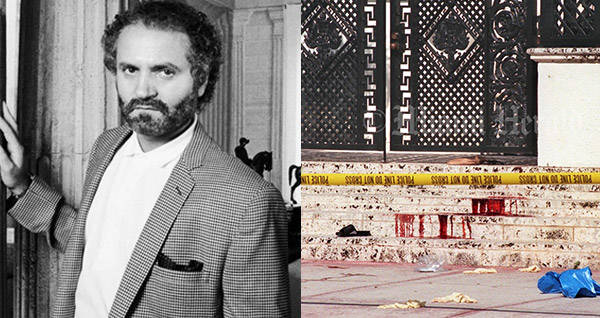
Giovanni Versace (left) and the crime scene outside his Miami Beach home where he was murdered by Andrew Cunanan on July 15, 1997.
The preceding article is an excerpt from Weird NJ magazine, “Your Travel Guide to New Jersey’s Local Legends and Best Kept Secrets,” which is available on newsstands throughout the state and on the web at www.WeirdNJ.com. All contents ©Weird NJ and may not be reproduced by any means without permission.
Visit our SHOP for all of your Weird NJ needs: Magazines, Books, Posters, Shirts, Patches, Stickers, Magnets, Air Fresheners. Show the world your Jersey pride some of our Jersey-centric goodies!
Now you can have all of your favorite Weird NJ icons on all kinds of cool new Weird Wear, Men’s Wear, Women’s Wear, Kids, Tee Shirts, Sweatshirts, Long Sleeve Tees, Hoodies, Tanks Tops, Tie Dyes, Hats, Mugs & Backpacks! All are available in all sizes and a variety of colors. Visit WEIRD NJ MERCH CENTRAL. Represent New Jersey!

